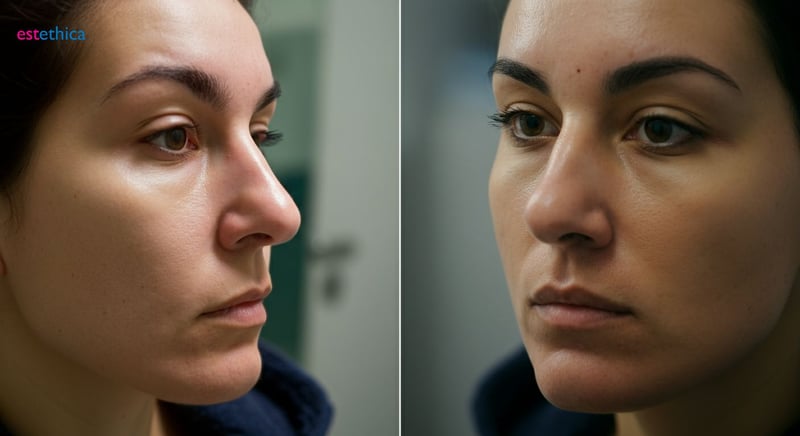Rhinoplasty Unveiled: Achieve Facial Harmony
Discover how rhinoplasty can enhance your facial harmony and improve breathing with estethica’s expert services.
Rhinoplasty, colloquially known as a 'nose job', is more than just a cosmetic procedure—it’s a gateway to achieving facial harmony and enhancing breathing functionality. At estethica, we prioritize patient safety and health, providing world-class aesthetic services that include advanced rhinoplasty techniques. Discover how rhinoplasty can transform both appearance and quality of life, and learn all you need about the recovery process.
Understanding Rhinoplasty: More Than Just a Nose Job
The Dual Benefit of Rhinoplasty: Aesthetics and Function
Rhinoplasty, commonly known as a nose job or nose surgery, is a surgical procedure designed to reshape the nose, enhancing its aesthetic appeal and correcting structural issues that may cause breathing difficulties. Ethnic rhinoplasty requires a nuanced approach, respecting the patient's heritage while achieving desired results. More than just a cosmetic enhancement, rhinoplasty addresses functional concerns such as deviated septums that obstruct airflow. The balance between form and function is at the heart of a successful Rhinoplasty procedure.
For many, rhinoplasty is a transformative procedure that offers both cosmetic and functional improvements. While a primary goal might be to refine the shape of the nose, rhinoplasty can also significantly improve breathing. According to a study, approximately 70% of patients who underwent rhinoplasty reported improved breathing post-surgery. Rhinoplasty’s precision-driven approach offers an opportunity to correct nasal asymmetries, addressing both aesthetic preferences and underlying structural anomalies. In cases of nasal trauma or congenital disabilities, nasal reconstruction through rhinoplasty offers life-changing results. You can find more information by exploring rhinoplasty options.
The Rhinoplasty Procedure: Addressing Structure and Aesthetics
The rhinoplasty procedure is meticulously customized to meet each patient's unique needs and goals. This may involve reshaping bone, cartilage, or both, to achieve the desired nasal contour. Surgeons often use advanced imaging techniques to plan the surgery, ensuring precision and optimal outcomes. Revision rhinoplasty may be necessary to correct or refine the results of a previous procedure, ensuring patient satisfaction. The cost of rhinoplasty can vary depending on the complexity of the procedure and the surgeon's expertise.
- Structural Enhancement: Rhinoplasty addresses structural issues in the nose, enhancing symmetry and overall facial balance. This leads to a harmonious aesthetic that complements the patient's features.
- Functional Improvement: Beyond aesthetics, rhinoplasty corrects breathing problems associated with structural nasal issues, improving the patient's quality of life.
- Personalized Approach: Rhinoplasty is customized to each patient's unique nasal anatomy and aesthetic goals, ensuring optimal results.
- Initial Consultation: Understanding the patient's goals and assessing their nasal structure.
- Surgical Procedure: Reshaping the nose through precise adjustments to bone and cartilage.
- Post-operative Care: Providing detailed instructions for a smooth recovery.

Breathing Better: How Rhinoplasty Addresses Functional Issues
Correcting Deviated Septum and Sinus Issues with Rhinoplasty
Beyond the cosmetic enhancements, rhinoplasty offers a significant advantage by addressing functional issues such as a deviated septum. A deviated septum can cause breathing difficulties, nasal congestion, and even chronic sinusitis. Rhinoplasty allows surgeons to correct this condition, opening up the nasal passages for improved airflow. By straightening the septum and reshaping the nasal structures, patients often experience a noticeable enhancement in their breathing capabilities and overall respiratory health.
Nasal valve collapse, another common issue that can be addressed during rhinoplasty, occurs when the sides of the nose weaken and narrow, obstructing airflow. Rhinoplasty can reinforce these structures, preventing collapse and ensuring better breathing. According to medical studies, approximately 85% of patients report significant relief from breathing issues after undergoing rhinoplasty to correct functional problems within the nose. Nasal reconstruction may also be recommended. Rhinoplasty offers a comprehensive solution to improve both the form and function of the nose. The expertise of top rhinoplasty surgeons is paramount in achieving successful results for nasal surgery. Seeking a rhinoplasty consultation is the first step toward determining if you're a suitable candidate.
- Improved Airflow: Rhinoplasty can reshape internal nasal structures to enhance airflow. This will lead to easier breathing and reduced congestion.
- Sinus Relief: By addressing structural issues, rhinoplasty can alleviate chronic sinusitis symptoms, improving overall sinus health.
- Enhanced Sleep Quality: Correcting breathing problems through rhinoplasty can lead to better sleep quality and reduced snoring.
Rhinoplasty: A Comprehensive Approach to Nasal Health
For individuals experiencing breathing difficulties due to structural abnormalities in the nose, rhinoplasty can provide a comprehensive solution. By addressing both the aesthetic and functional aspects of the nose, this procedure offers a unique opportunity for improving overall quality of life. Whether the goal is to correct a long-standing deviated septum or to refine the nasal shape, rhinoplasty offers a tailored approach to meet individual needs. Rhinoplasty recovery tips often include managing swelling and discomfort with prescribed medication. This proactive approach makes rhinoplasty an attractive option for those seeking comprehensive nasal enhancement.
The marriage of cosmetic and functional benefits makes rhinoplasty an appealing option for individuals seeking to enhance their appearance while resolving underlying health issues. The before and after results showcase the transformative impact that rhinoplasty can have, not only on physical appearance but also on overall well-being. In fact, rhinoplasty's increasing popularity is due to its ability to address both cosmetic desires and functional needs in a single procedure. Patients explore rhinoplasty England or other locations to find skilled surgeons and advanced techniques.
- Evaluation: A thorough assessment to determine the functional problems.
- Surgical Correction: Addressing structural issues, such as deviated septums.
- Aesthetic Refinement: Enhancing the nose's shape while maintaining functionality.

Ethnic Rhinoplasty: Tailoring the Procedure to Your Heritage
Understanding the Nuances of Ethnic Rhinoplasty
Ethnic rhinoplasty is a specialized field that recognizes and respects the unique anatomical features and cultural values of various ethnic groups. Unlike traditional rhinoplasty, ethnic rhinoplasty aims to enhance the nose while preserving its ethnic identity. This approach requires surgeons to have a deep understanding of different nasal structures and aesthetic preferences. By tailoring the procedure to each patient's specific background, surgeons can achieve harmonious and natural-looking results that honor their heritage.
The goal of ethnic rhinoplasty is not to Westernize the nose but rather to refine its appearance in a way that complements the patient's overall facial features. This may involve addressing concerns such as a wide nasal bridge, thick skin, or a lack of definition in the nasal tip. According to the American Academy of Facial Plastic and Reconstructive Surgery, there has been a 25% increase in ethnic rhinoplasty procedures. Rhinoplasty can be a transformative experience, boosting self-confidence and improving overall facial harmony. The techniques used in ethnic rhinoplasty reflect a commitment to cultural sensitivity and individualized care.
- Cultural Sensitivity: Ethnic rhinoplasty respects cultural values and aesthetic preferences. This ensures results align with the patient's ethnic identity.
- Preservation of Identity: The goal is to enhance, not erase, ethnic characteristics of the nose, maintaining a natural appearance.
- Individualized Approach: Tailoring the procedure to each patient's unique nasal structure and aesthetic goals.
Techniques in Ethnic Rhinoplasty: Achieving Natural Harmony
Ethnic rhinoplasty utilizes a range of techniques to address the specific characteristics of different ethnic noses. Open rhinoplasty vs closed rhinoplasty approaches might be selected based on the patient's unique needs. For example, dorsal hump reduction might be approached cautiously to avoid an overly aggressive change that doesn't suit the patient's ethnicity. Liquid nose job procedures are also an option. Cartilage grafting is used to add definition and support to the nasal tip, while osteotomies reshape the nasal bones. The choice of technique depends on the patient's anatomy, aesthetic goals, and ethnic background. Rhinoplasty consultation is a step in identifying the best options.
The surgeon's expertise in ethnic rhinoplasty is crucial for achieving successful outcomes. They must have a keen eye for detail and a deep understanding of facial aesthetics. By combining surgical skill with an artistic vision, they can create a nose that is both beautiful and harmonious with the patient's overall appearance. Rhinoplasty recovery time is influenced by the specific techniques used and the patient's healing ability. Examples of successful ethnic rhinoplasty include refining a wide nasal bridge, enhancing a flat nasal tip, or improving nasal symmetry. These results reflect the surgeon's ability to customize the procedure to each patient's unique needs.
- Assessment: Analyzing the patient's nasal structure and ethnic background.
- Planning: Customizing the surgical approach to achieve desired outcomes.
- Execution: Utilizing precise surgical techniques to enhance the nose while preserving its ethnic identity.

Rhinoplasty Recovery Time: What to Expect Day by Day
Immediate Post-Op Care: Days 1-3 After Rhinoplasty
The initial days following rhinoplasty, typically days 1 to 3, are crucial for recovery. During this period, patients can expect swelling, bruising, and discomfort around the nose and eyes. Managing pain effectively is paramount, often achieved through prescribed medication. It is also essential to keep the head elevated to minimize swelling and promote healing. Remember that each person's recovery can vary based on their individual health and the extent of the surgical procedure they have undergone. Adhering to your surgeon’s specific post-operative instructions is essential for ensuring a smooth rhinoplasty recovery.
The first 72 hours are characterized by the body's natural inflammatory response. Patients are advised to avoid strenuous activities, which could exacerbate swelling and bleeding. Gentle care and adherence to post-op guidelines, such as using cold compresses, can provide relief and expedite the healing process. Rhinoplasty before and after results largely depend on this immediate post-operative care. Approximately 90% of patients report that diligent adherence to post-op instructions significantly improves their comfort during this initial phase. This period sets the stage for the subsequent healing and refinement of the nasal contours following your nose surgery.
- Rest and Elevation: Prioritize rest and keep your head elevated to minimize swelling.
- Pain Management: Take prescribed pain medication as directed to stay comfortable.
- Cold Compresses: Apply cold compresses to reduce swelling and bruising.
Two Weeks and Beyond: The Gradual Transformation After Your Nose Job
By the end of the first two weeks, noticeable improvements begin to emerge following a Rhinoplasty procedure. Much of the initial swelling and bruising starts to subside, revealing the early contours of the reshaped nose. While visible progress is evident, the nose continues to refine over the next several months. Adherence to post-operative care is crucial for optimizing results and ensuring proper healing during this phase. Regular follow-up appointments with your surgeon are important to monitor progress and address any concerns that may arise during the recovery process.
It's essential to understand that the final results of rhinoplasty may take up to a year or more to fully materialize. Subtle changes continue to occur as the tissues settle and remodel. Patients are advised to be patient and maintain realistic expectations. Non-surgical rhinoplasty, or a liquid nose job, involves injectable fillers to temporarily reshape the nose without surgery, although it may not address functional issues. Rhinoplasty cost is a common consideration, highlighting the importance of understanding the financial aspect of surgery. The gradual transformation underscores the importance of long-term commitment to post-operative care in achieving the desired outcome from rhinoplasty.
- Swelling Reduction: Monitor the gradual reduction of swelling over several weeks.
- Contour Refinement: Observe how the shape of your nose refines as healing progresses.
- Patience and Monitoring: Be patient with the process and attend all follow-up appointments.
Rhinoplasty: Everything You Need to Know
Advanced Rhinoplasty Techniques Correcting Functional Issues and Enhancing Aesthetics
Personalized Post-Operative Care Ensuring Smooth Rhinoplasty Recovery and Optimal Results
Frequently Asked Questions
What is Rhinoplasty and what are its benefits?
How does Rhinoplasty address functional breathing issues?
What is Ethnic Rhinoplasty and how does it differ from traditional Rhinoplasty?
What can I expect during the Rhinoplasty recovery time?
What are the alternatives to surgical Rhinoplasty?
Achieve your aesthetic goals with estethica's expert team and personalized treatment plans.
📞 Call for a Free Consultation!